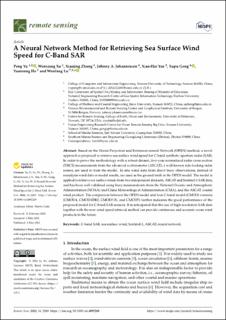| dc.contributor.author | Yu, Peng | |
| dc.contributor.author | Xu, Wenxiang | |
| dc.contributor.author | Zhong, Xiaojing | |
| dc.contributor.author | Johannessen, Johnny Andre | |
| dc.contributor.author | Yan, Xiao-Hai | |
| dc.contributor.author | Geng, Xupu | |
| dc.contributor.author | He, Yuanrong | |
| dc.contributor.author | Lu, Wenfang | |
| dc.date.accessioned | 2022-12-29T14:32:02Z | |
| dc.date.available | 2022-12-29T14:32:02Z | |
| dc.date.created | 2022-10-06T15:14:50Z | |
| dc.date.issued | 2022-05-08 | |
| dc.identifier.issn | 2072-4292 | |
| dc.identifier.uri | https://hdl.handle.net/11250/3039936 | |
| dc.description.abstract | Based on the Ocean Projection and Extension neural Network (OPEN) method, a novel approach is proposed to retrieve sea surface wind speed for C-band synthetic aperture radar (SAR). In order to prove the methodology with a robust dataset, five-year normalized radar cross section (NRCS) measurements from the advanced scatterometer (ASCAT), a well-known side-looking radar sensor, are used to train the model. In situ wind data from direct buoy observations, instead of reanalysis wind data or model results, are used as the ground truth in the OPEN model. The model is applied to retrieve sea surface winds from two independent data sets, ASCAT and Sentinel-1 SAR data, and has been well-validated using buoy measurements from the National Oceanic and Atmospheric Administration (NOAA) and China Meteorological Administration (CMA), and the ASCAT coastal wind product. The comparison between the OPEN model and four C-band model (CMOD) versions (CMOD4, CMOD-IFR2, CMOD5.N, and CMOD7) further indicates the good performance of the proposed model for C-band SAR sensors. It is anticipated that the use of high-resolution SAR data together with the new wind speed retrieval method can provide continuous and accurate ocean wind products in the future. | en_US |
| dc.language.iso | eng | en_US |
| dc.publisher | MDPI | en_US |
| dc.rights | Navngivelse 4.0 Internasjonal | * |
| dc.rights.uri | http://creativecommons.org/licenses/by/4.0/deed.no | * |
| dc.title | A Neural Network Method for Retrieving Sea Surface Wind Speed for C-Band SAR | en_US |
| dc.type | Journal article | en_US |
| dc.type | Peer reviewed | en_US |
| dc.description.version | publishedVersion | en_US |
| dc.rights.holder | Copyright 2022 the authors | en_US |
| dc.source.articlenumber | 2269 | en_US |
| cristin.ispublished | true | |
| cristin.fulltext | original | |
| cristin.qualitycode | 1 | |
| dc.identifier.doi | 10.3390/rs14092269 | |
| dc.identifier.cristin | 2059285 | |
| dc.source.journal | Remote Sensing | en_US |
| dc.identifier.citation | Remote Sensing. 2022, 14 (9), 2269. | en_US |
| dc.source.volume | 14 | en_US |
| dc.source.issue | 9 | en_US |

